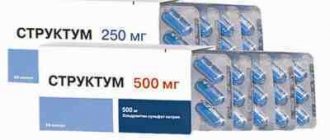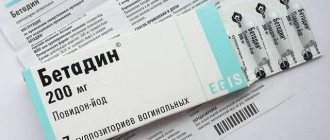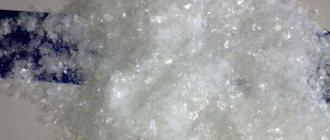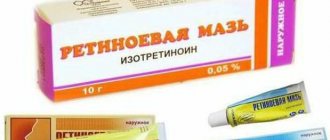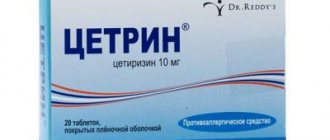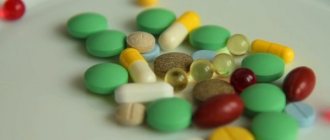Polyoxidonium is a medicine that stimulates the immune system and has a detoxifying effect on the body. Instructions for use explain how to properly take 12 mg tablets, 6 mg and 12 mg suppositories, injections in 3 mg and 6 mg injection ampoules for the treatment of immunodeficiencies. What Polyoxidonium helps with, information on prices, analogues and patient reviews will also be presented in the article.
Release form and composition
Polyoxidonium has three dosage forms:
- Tablets 12 mg.
- Suppositories for vaginal or rectal use 6 mg and 12 mg.
- Lyophilisate for the preparation of a solution for injection and local use (injections in ampoules) 3 mg and 6 mg.
The suppositories are torpedo-shaped, light yellow in color and have a specific smell of cocoa butter.
The tablets are flat-cylindrical, each of them has a chamfer. Their color can vary from yellowish-white to orange-yellow. The presence of slightly noticeable particles of more intense color is allowed in tablets.
One Polyoxidonium tablet contains 12 mg of the active ingredient azoximer bromide, as well as potato starch (Amylum solani), lactose monohydrate, stearic acid (Acidum stearicum) as auxiliary components.
One bottle of lyophilisate contains 6 mg of active ingredient, as well as mannitol (E421 Mannit), povidone (Povidonum) and beta-carotene (Betacarotenum) as auxiliary components.
To make one rectal-vaginal suppository, 6 or 12 mg of active ingredient and auxiliary components are used: mannitol (E421 Mannit), povidone (Povidonum), beta-carotene (Betacarotenum), cocoa butter (Butyrum Cacao).
Indications and contraindications for the use of Polyoxidonium
The drug is prescribed if necessary to improve immunity. This is an excellent curative and preventive agent in urology, gynecology, pediatrics, and surgery. In addition, such a prescription is quite appropriate for patients with cancer, which significantly facilitates the quality of life and its duration. Polyoxidonium is also considered an excellent preventive measure against influenza, colds and acute respiratory viral infections. Simply put, it is prescribed for reduced immunity, as well as in the presence of an inflammatory process of any origin or a long course of antibacterial therapy.
The immunostimulant has a gentle effect, and the list of contraindications includes increased sensitivity of the body to the active substances, as well as the period of pregnancy. Use with caution in children and patients with damaged kidneys.
Pharmacological characteristics
Polyoxidonium is a drug that has immunomodulatory and detoxification properties. Increases the body's resistance to various infectious diseases.
It is capable of normalizing the immune status in severe forms of immunodeficiency, including secondary immunodeficiency, due to damage by ionizing radiation, during treatment with hormones and cytostatics, after operations, severe injuries, burns and malignant tumors.
Reduces the toxicity of medications and various toxic substances, increasing the resistance of cell membranes to the cytotoxic effects of these substances.
General description of Polyoxidonium
Polyoxidonium is an immunomodulatory drug that enhances the body's resistance to local and generalized infections. Its active component is azoximer bromide, which has a direct effect on natural killer and phagocytic cells. Thus, the drug effectively eliminates immunodeficiency conditions caused by various infections, burns, injuries, malignant tumors, as well as serious complications after surgical procedures. In addition, it increases the resistance of cell membranes to the effects of chemicals and drugs, in particular, significantly reduces their toxicity.
Polyoxidonium is effective both as part of complex therapy and as an independent treatment agent, and does not have embryotoxic, mutagenic, teratogenic, allergenic or carcinogenic effects in the body. It is productively absorbed from the gastrointestinal tract, and its maximum concentration in the blood is noticeable within an hour. Excreted by the kidneys.
The immunostimulant is produced in the form of a lyophilisate to create a solution, tablets and suppositories.
Analogues of Polyoxidonium are Immunofan, Wobenzym, Ginsomin, Immunomax, Imunoplus, Imuno-tone, Coenzyme Compositum, Protfenoloside and Immunovit S.
Why is Polyoxidonium prescribed?
Correction of immunity in adults and children from 6 months.
In adults in complex therapy:
- chronic recurrent infectious and inflammatory diseases that are not amenable to standard therapy in the acute stage and in remission;
- acute and chronic viral and bacterial infections (including urogenital infectious and inflammatory diseases);
- tuberculosis;
- acute and chronic allergic diseases (including hay fever, bronchial asthma, atopic dermatitis), complicated by chronic recurrent bacterial and viral infections;
- in oncology during and after chemotherapy and radiation therapy to reduce the immunosuppressive, nephro- and hepatotoxic effects of drugs;
- to activate regenerative processes (fractures, burns, trophic ulcers);
- rheumatoid arthritis treated for a long time with immunosuppressants;
- with rheumatoid arthritis complicated by acute respiratory infections;
- for the prevention of postoperative infectious complications;
- for the prevention of influenza and acute respiratory infections.
In children in complex therapy:
- acute and chronic inflammatory diseases caused by pathogens of bacterial, viral, fungal infections (including ENT organs - sinusitis, rhinitis, adenoiditis, hypertrophy of the pharyngeal tonsil, ARVI);
- acute allergic and toxic-allergic conditions;
- bronchial asthma complicated by chronic respiratory tract infections;
- atopic dermatitis complicated by purulent infection;
- intestinal dysbiosis (in combination with specific therapy);
- for the rehabilitation of those who are often and long-term ill;
- prevention of influenza and acute respiratory infections.
Suppositories "POLYOXIDONIUM": indications for use
Rectal or vaginal suppositories:
- stimulate the body’s own immune response, increases the amount of immunoglobulins A, which are synthesized in the B cells of the intestine;
- improves the functioning of lymphoid cells of internal organs, increasing the body's resistance to infection.
The drug is used as an independent medicine, without combination with other drugs, for the prevention of:
- exacerbations of diseases caused by the herpes simplex virus;
- seasonal colds;
- influenza epidemics;
- secondary immunodeficiencies due to aging or working in harmful conditions,
- as well as to reduce the hepato- and nephrotoxicity of drugs that are difficult for patients to tolerate.
Suppositories are prescribed as part of complex therapy, in accordance with the indications for the use of Polyoxidonium suppositories:
- inflammation of a chronic nature, both during remission and during the acute period;
- acute inflammatory diseases caused by bacteria, fungi or viruses;
- therapy for acute and chronic inflammation of the urinary tract and reproductive system, caused by both common and specific flora;
- complicated/uncomplicated allergy;
- tuberculosis process of any localization;
- fractures, burns, and other severe injuries to stimulate one’s own immunity and regenerative processes;
- prevention of frequently recurring exacerbations of any inflammatory processes;
- chemo- and radiation therapy of malignant tumors.
Contraindications
- if you are intolerant to the active substance or cocoa butter;
- pregnant, lactating;
- children under 6 years old;
- for acute renal failure (in chronic form, use 2 times a week under medical supervision is allowed).
Side effects
In clinical trials of the drug, no teratogenic, allergenic, mutagenic, embryotoxic, or carcinogenic effects were found. The drug is recommended for the treatment of patients with allergies; it is prescribed with caution in case of individual intolerance to the components.
Instructions for use
Polyoxidonium tablets are taken orally whole, not chewed and washed down with a sufficient amount of water or applied sublingually (tablets are placed under the tongue until completely dissolved).
The average dose for adolescents under 18 years of age is 12 mg, for adults 24 mg in several doses (usually 2-3 times a day), which depends on the method of use of the drug, the age of the patient, and the pathological process. Sublingual tablets are used in the following dosages:
- Infectious and inflammatory pathology of the oral cavity and pharynx – 12 mg (1 tablet) 2 times a day (morning and evening) for 10-14 days.
- Herpetic or severe fungal infection of the oral mucosa - 12 mg 3 times a day (every 8 hours) for 15 days.
- Chronic sinusitis (inflammation of the paranasal sinuses) or otitis (inflammation of the middle or inner ear) - 12 mg 2 times a day for 5-10 days.
- Chronic tonsillitis (inflammation of the tonsils) – 12 mg 3 times a day for 10-15 days.
- Chronic inflammatory pathology of the upper respiratory tract - adults 24 mg 2 times a day, adolescents under 18 years old 12 mg 2 times a day for 10-14 days.
Prevention of influenza and other acute respiratory viral pathologies - in the pre-epidemic period (the time before the expected increase in the incidence of colds or flu, usually the winter-spring period), the dose for adults is 24 mg 2 times a day, for children - 12 mg 2 times a day within 10-15 days.
Orally (orally) Polyoxidonium tablets are taken for chronic infectious-inflammatory pathology of the respiratory tract, the dosage for adults is 24 mg 2 times a day, for adolescents under 18 years old - 12 mg 2 times a day for 10-14 days. If necessary, the doctor can adjust the method of administration, dosage, regimen of the drug and the duration of the course of treatment.
Instructions for use of Polyoxidonium in the form of lyophilisate
The solution is administered intramuscularly or by drip into a vein, and used intranasally.
- For the treatment of acute inflammatory diseases, the drug is administered daily for 3 days at a dose of 6 mg. Further, Polyoxidonium injections continue to be given every other day. Typically, the patient requires five to ten injections.
- For the treatment of chronic inflammatory diseases and rheumatoid arthritis, the first 5 injections are given every other day, then the drug is continued to be administered 2 times a week. A single dose of the active substance is 6 mg. The full course involves at least ten injections.
- Patients diagnosed with tuberculosis are prescribed 6 mg of the drug 2 times a week. The full course is from ten to twenty injections.
- For patients with diseases of the urogenital tract, ten injections are recommended (every other day). Single dose - 6 mg. Therapy is supplemented with the prescription of chemotherapy drugs.
Patients with chronic recurrent herpes are also treated using a similar scheme. In this case, Polyoxidonium is prescribed in combination with stimulators of endogenous interferon synthesis, antiviral agents, and interferon preparations.
Therapy for complicated allergic diseases involves administering five single doses of the drug (6 mg) to the patient. The first two injections are recommended to be given daily, the remaining three injections are given every other day.
For allergies and toxic-allergic lesions, intravenous administration of a dose of 6-12 mg is indicated in combination with drugs that have an antiallergic effect (including Clemastine).
For patients undergoing chemotherapy (as well as after its completion), to reduce the specific effect of chemotherapeutic agents, the drug is prescribed in a dose of 6-12 mg. It is considered optimal to carry out at least ten injections (maintaining a daily interval between them).
To correct the immunodeficiency state after radiation and chemotherapy, after surgical removal of the tumor, the patient is administered a dose of 6 mg 1-2 times a week. The course of treatment is quite long - usually from 2-3 to 12 months.
According to the instructions for use, Polyoxidonium injections are allowed to be administered to patients with acute renal failure no more than 2 times a week.
To prepare a solution for intramuscular injection, 6 mg of the active substance (the contents of one ampoule or bottle) is combined with 1.5-2 ml of NaCl solution or water for injection.
A solution for drip administration into a vein is prepared by mixing the contents of one ampoule or bottle with 3 ml of NaCl solution, Hemodez, plasma replacement drug Reopoliglucin or 5% glucose solution. The resulting solution must be transferred under sterile conditions into a bottle with any of the above solutions with a volume of 0.2-0.4 liters.
The solution for parenteral administration must be used immediately after preparation; it cannot be stored.
How to inject the solution into the nose
Intranasal use is indicated for acute and chronic infectious ENT diseases, to accelerate the regeneration of mucous membranes, to prevent the development of complications and relapses of diseases, to prevent influenza and respiratory diseases.
To prepare a nasal solution, 6 mg of lyophilisate is combined with one milliliter (20 drops) of distilled water, NaCl solution or ordinary boiled water. In this case, the temperature of the liquid should be room temperature.
The solution is injected into each nasal passage at least 3-4 times during the day, leaving 2-3 hours between instillations. Single dose: 1 to 3 drops in each nostril. Treatment is continued for five to ten days.
After dilution, the drug remains stable for 24 hours, after which it cannot be used.
Candles
The drug is intended for rectal and intravaginal administration, 1 suppository 1 time per day. The method and dosage regimen is determined by the doctor depending on the diagnosis, severity and severity of the process. The drug can be used daily, every other day or 2 times a week.
Suppositories 12 mg are used rectally and intravaginally in adults.
Suppositories 6 mg are used rectally in children over 6 years of age; in adults rectally and intravaginally as maintenance therapy.
Rectally, suppositories are inserted into the rectum after cleansing the intestines. Intravaginally, suppositories are inserted into the vagina in a lying position once a day at night.
Standard application scheme
1 suppository 6 mg or 12 mg 1 time per day daily for 3 days, then every other day in a course of 10-20 suppositories.
Read also: Cardiket: instructions for use, prices and analogues
If necessary, the course of treatment is repeated after 3-4 months.
Patients with chronic immune deficiency (including those receiving immunosuppressive therapy for a long time, with cancer, HIV, and those exposed to radiation) are prescribed long-term maintenance therapy with Polyoxidonium from 2-3 months to 1 year (adults 12 mg, children over 6 years old - according to 6 mg 1-2 times a week).
Variants of recommended regimens for use as part of complex therapy
- For chronic infectious and inflammatory diseases in the acute stage - according to the standard regimen, in the remission stage - 1 suppository of 12 mg every 1-2 days, a total course of 10-15 suppositories.
- For acute infectious processes and to activate regenerative processes (fractures, burns, trophic ulcers) - 1 suppository daily. The course of treatment is 10-15 suppositories.
- For tuberculosis, the drug is prescribed according to the standard regimen. The course of treatment is at least 15 suppositories, then it is possible to use maintenance therapy of 2 suppositories per week for up to 2-3 months.
- During chemotherapy and radiation therapy of tumors, 1 suppository is started to be administered daily 2-3 days before the start of the course of therapy. Further, the frequency of administration of suppositories is determined by the doctor depending on the nature and duration of chemotherapy and radiation therapy.
- For rehabilitation of frequent (more than 4-5 times a year) long-term ill people and rheumatoid arthritis - 1 suppository every other day. The course of treatment is 10-15 suppositories.
- For the correction of secondary immunodeficiencies, incl. arising due to aging, Polyoxidonium is used at a dose of 12 mg (1 supp.) 2 times a week. The course is at least 10 suppositories 2-3 times a year.
As monotherapy
For seasonal prevention of exacerbations of chronic infectious diseases and for the prevention of recurrent herpetic infections, the drug is used every other day in adults, 6-12 mg, in children - 6 mg. Course - 10 suppositories.
To correct secondary immunodeficiencies, prevent influenza and acute respiratory infections, the drug is prescribed according to the standard regimen.
For gynecological diseases, the drug is prescribed rectally and intravaginally according to the standard regimen.
Instructions for use Polyoxidonium
The immunostimulant is intended for intravaginal and rectal administration, and the method of use, dose and pharmacological execution must be discussed with the attending physician on an individual basis. Instructions for use Polyoxidonium recommends using it every day, every other day or twice a week.
Polyoxidonium suppositories in adults are used rectally and vaginally. For rectal use, preliminary cleansing of the intestines is indicated, after which the suppository must be inserted into the rectum. Intravaginally, suppositories are administered in a lying position into the vagina once a day, preferably at night.
So, in the general treatment regimen, the drug is prescribed rectally as a suppository (6 mg or 12 mg) daily for the first three days, and then every 48 hours. One course contains 10-15 suppositories. Repeated therapy with Polyoxidonium is appropriate after three months. Treatment regimens for various diagnoses are described in detail in the attached annotation.
How to take it for children?
In pediatric practice, the use of tablets is allowed from the age of 3, suppositories are used from the age of six, and lyophilisate is used from six months.
For children, Polyoxidonium is prescribed as an addition to the main therapy. Indications for use are acute and chronic infectious and inflammatory diseases (including acute respiratory viral infections and ENT diseases), allergies and toxic-allergic conditions, complicated by chronic infectious processes in the respiratory tract, bronchial asthma, occurring with complications (including complicated by purulent infection) atopic dermatitis, dysbacteriosis.
For children included in the “ChBD” group, the drug is used to speed up the process of their rehabilitation. In addition, Polyoxidonium has a preventive effect against influenza and colds.
Tablets are taken sublingually or orally at a dose of 6 mg (half a tablet), daily, with a frequency of applications 1, 2 or 3 times a day.
The optimal dose, number and frequency of injections are determined depending on the diagnosis and age of the child:
For acute inflammatory diseases, five to seven injections are recommended every other day. Dose: 100 mcg/kg. If the disease is chronic, the dose is increased to 150 mcg/kg. The drug is administered every other day. The course involves the administration of up to ten single doses.
For the treatment of allergies and toxic-allergic conditions, drip administration of the drug into a vein at a dose of 150 mcg/kg is indicated. Therapy is supplemented with the prescription of Clemastine and other drugs that have an antiallergic effect. If the disease occurs with complications, injections are prescribed as an addition to basic therapy. The patient is indicated for 5 intramuscular injections at a dose of 100 mcg/kg. The interval between administrations is 1-2 days.
A solution for intramuscular administration is prepared by dissolving 3 mg of the drug in 1 ml of NaCl solution (water for injection can be used).
A solution for intravenous administration is prepared by diluting 3 mg of the drug in 1.5-2 ml of NaCl solution, 5% glucose solution, Polyglucin or Hemodez, after which, under sterile conditions, it is added to a bottle with one of the indicated solutions in a volume of 0.15-0.25 l.
Intranasal Polyoxidonium is used daily for five to ten days, instilling it at least 3-4 times a day into each nostril in a dose of 1 to 3 drops. The daily dose is 150 mcg/kg body weight. The interval between procedures is 2-3 hours.
To prepare a solution for topical use, add 1 ml (equivalent to 20 drops) of liquid at room temperature (0.9% NaCl solution, distilled or ordinary boiled water) to 3 mg of the drug.
For children, the solution is prescribed at a dose of 150 mcg of the active substance per kilogram of body weight (this amount is contained in one drop of the solution).
The drug is prescribed to be taken sublingually daily for 10 days. The daily dose for all indications is 150 mcg/kg. If the drug is used to treat dysbiosis, the course usually lasts from 10 to 20 days.
The solution is stored in the refrigerator for no more than one week. Before instilling the drug, the pipette with the solution must be warmed to room temperature.
According to the instructions for suppositories for children, the drug in this dosage form can be used rectally to treat patients over 6 years of age. According to the doctor’s indications, suppositories are administered one at a time daily or every other day before bedtime.
Polyoxidonium suppositories for children - reviews confirm this - are an effective remedy, however, the desired effect from their use can only be achieved in cases where the treatment regimen is selected by an experienced doctor and takes into account the characteristics of the disease and the body of a particular child.
Use of the drug Polyoxidonium
Adults: IM or IV (drip), single dose - 6-12 mg 1 time per day, daily, every other day, 2 or 1 time per week, depending on the diagnosis and severity of the disease. For intramuscular administration, the contents of the bottle are dissolved in 1.5–2 ml of water for injection or isotonic sodium chloride solution; for intravenous drip - in 2-3 ml of isotonic solution of sodium chloride or dextran, under aseptic conditions transferred to a bottle with the indicated solutions of 200-400 ml. Adults For acute inflammatory diseases - 6 mg daily for 3 days, then every other day, 5-10 injections per course. For chronic inflammatory diseases - 5 injections of 6 mg every other day, then 2 times a week, for a course - 10 injections. For tuberculosis - 6 mg 2 times a week, 10–20 injections per course. For acute and chronic diseases of the genitourinary system - 6 mg, per course - 10 injections every other day, in combination with antibacterial drugs. For chronic recurrent herpes - 6 mg every other day, per course - 10 injections, in combination with antiherpetic drugs, interferons or inducers of endogenous interferon synthesis. For complicated forms of allergic diseases - 6 mg, 5 injections per course (the first 2 - daily, then every other day). For acute allergic and toxic-allergic conditions - 6–12 mg IV in combination with antihistamines and other antiallergic drugs. For cancer - before and during chemotherapy, 6–12 mg every other day, for a course of at least 10 injections. To correct immunodeficiency after chemotherapy and radiation therapy - 6 mg 1-2 times a week from 2-3 months to 1 year. Children aged 6 months or older IM or IV drip at a dose of 0.1–0.15 mg/kg 1 time per day, every other day, 5–7 injections per course. For intramuscular administration, 3 mg of polyoxidonium is dissolved in 1–1.5 ml of isotonic sodium chloride solution. For intravenous administration, 1.5–2 ml of a sterile isotonic solution of sodium chloride, dextrose or dextran is transferred under aseptic conditions into bottles with the indicated solutions of 150–250 ml. It can also be administered sublingually or intranasally, once daily at a dose of 0.1–0.15 mg/kg for 10 days. Instill 3–5 drops of the solution into each nasal passage (if more than 10 drops are prescribed, instill 3–5 drops in fractions every 10–15 minutes). For sublingual and intranasal use, 3 mg of polyoxidonium is dissolved in 1 ml of distilled water (0.15 mg - 1 drop). Acute inflammatory diseases - 0.1 mg/kg intramuscularly every other day, 5-7 injections per course. Chronic inflammatory diseases - 0.1–0.15 mg/kg IM 2 times a week, 7–10 injections per course. Acute allergic and toxic-allergic conditions - IV drip at a dose of 0.1–0.15 mg/kg in combination with antiallergic drugs. Complicated forms of allergic diseases (in combination with basic therapy) - IV drip or IM 0.1 mg/kg in a course of 5 injections with an interval of 1-2 days. Intestinal dysbiosis - 0.1–0.15 mg/kg sublingually daily for 5–10 days. Intravaginal polyoxidonium is used in conjunction with standard therapy for chronic salpingoophoritis, endometritis, colpitis, diseases caused by the human papillomavirus, ectopia, dysplasia and leukoplakia of the cervix, 1 suppository (12 mg) daily for 3 days, and then every other day. The course of treatment is 10 suppositories.
Analogs
Analogs of the drug by mechanism of action: Actinolysate, Anaferon, Arpetolide, Arpeflu, Affinoleukin, Bestin, Bioaron, Broncho-Vaxom, Vilozen, Gepon, Herbion, Glutaxim, Isophone, Immunal, Immunofan, Neuroferon, Ribomunil, Taktivin, Florexil, Cycloferon, Tsitovir- 3, Engistol, Polymuramil, Ismigen.
When choosing analogues, it is important to understand that the instructions for use of Polyoxidonium, price and reviews do not apply to drugs with similar effects. It is important to consult a doctor and not change the drug yourself.
special instructions
Do not exceed the indicated doses and duration of treatment.
If there is pain at the injection site during intramuscular administration, the drug is dissolved in 1 ml of 0.25% procaine solution if the patient does not have increased individual sensitivity to procaine.
When administered intravenously (drip), it should not be dissolved in protein-containing infusion solutions.
Impact on the ability to drive vehicles and operate machinery
Does not affect the ability to drive a car or operate machinery.
What do the reviews say?
Reviews of Polyoxidonium suppositories, tablets and solution are evidence of the effectiveness of each of these dosage forms. When using the drug in complex therapy, the patient recovers faster, and the disease proceeds in a much milder form.
Using the medicine as a prophylactic agent for children can reduce the incidence of diseases. Reviews from doctors about Polyoxidonium allow us to conclude that this remedy is truly irreplaceable.
Prescribing suppositories, tablets or nasal solution to children promotes faster adaptation to being in a group (at school or kindergarten). At the same time, children are much less susceptible to infections even during periods of seasonal epidemics.
Most of the positive reviews of Polyoxidonium in suppositories and other dosage forms are due to the fact that the drug is easy to use, well tolerated by children and practically does not cause side effects.
For adults, Polyoxidonium is most often prescribed for the treatment of infectious diseases. The use of suppositories in gynecology in combination with basic therapy not only helps to effectively eliminate the symptoms of the disease, but also significantly increases immunity and, accordingly, helps prevent relapses and complications.
Having analyzed reviews of Polyoxidonium injections, we can confidently say that the drug has a positive effect even in quite complex cases when the patient’s body is weakened by cancer and its treatment
1 272
Instructions for use Polyoxidonium tablets 12 mg1
Read these instructions carefully before you start using this medicine because they contain information that is important to you. Save the instructions, you may need them again. If you have any questions, consult your doctor. This medicine is available without a prescription. To achieve optimal results, it should be used strictly following all recommendations outlined in the instructions. The medicine you are using is intended for you personally and should not be given to others as it may cause harm to them even if they have the same symptoms as you.
Registration number: P N002935/04 Trade name : Polyoxidonium® International nonproprietary name : Azoximer bromide (Azoximeri bromidum) Chemical name: copolymer of 1,4-ethylenepiperazine N-oxide and (N-carboxymethyl)-1,4-ethylenepiperazinium bromide Dosage form: tablets Composition per tablet: Active ingredient: Azoximer bromide – 12 mg; Excipients: mannitol - 3.6 mg, povidone - 2.4 mg, lactose monohydrate - 185.0 mg, potato starch - 45.0 mg, stearic acid - 2.0 mg. Description : Round, flat-cylindrical tablets of white or white with a yellowish tint, with a chamfer, with a score - on one side and embossed "PO" - on the other. Pharmacotherapeutic group : immunomodulatory agent. ATX code: [LO3]
Pharmacodynamics
Azoximer bromide has a complex effect: immunomodulatory, detoxifying, antioxidant, moderate anti-inflammatory. The basis of the mechanism of immunomodulatory action of Azoximer bromide is a direct effect on phagocytic cells and natural killer cells, as well as stimulation of antibody formation and the synthesis of interferon-alpha and interferon-gamma. The detoxification and antioxidant properties of Azoximer bromide are largely determined by the structure and high-molecular nature of the drug. Azoximer bromide increases the body's resistance to local and generalized infections of bacterial, fungal and viral etiology. Restores immunity in secondary immunodeficiency conditions caused by various infections, injuries, complications after surgical operations. A characteristic feature of Azoximer bromide when applied topically (sublingually) is the ability to activate factors of the body's early defense against infection: the drug stimulates the bactericidal properties of neutrophils, macrophages, enhances their ability to absorb bacteria, increases the bactericidal properties of saliva and secretions of the mucous membranes of the upper respiratory tract. When administered orally, Azoximer bromide also activates lymphoid cells in the intestinal lymph nodes. Azoximer bromide blocks soluble toxic substances and microparticles, has the ability to remove toxins and heavy metal salts from the body, and inhibits lipid peroxidation, both by intercepting free radicals and by eliminating catalytically active Fe2+ ions. Azoximer bromide reduces the inflammatory response by normalizing the synthesis of pro- and anti-inflammatory cytokines. Azoximer bromide is well tolerated, does not have mitogenic, polyclonal activity, antigenic properties, does not have allergenic, mutagenic, embryotoxic, teratogenic and carcinogenic effects. Azoximer bromide is odorless and tasteless, and does not have a local irritating effect when applied to the mucous membranes of the nose and oropharynx.
Pharmacokinetics
After oral administration, azoximer bromide is rapidly absorbed from the gastrointestinal tract; the bioavailability of the drug when administered orally is more than 70%. The maximum concentration in blood plasma is achieved 3 hours after ingestion. The pharmacokinetics of Azoximer bromide is linear (plasma concentration is proportional to the dose taken). Azoximer bromide is a hydrophilic compound. The apparent volume of distribution is approximately 0.5 l/kg, which indicates that the drug is distributed mainly in the interstitial fluid. The half-life of absorption is 35 minutes, the half-life is 18 hours. Azoximer bromide is quickly distributed throughout all organs and tissues of the body, penetrates the blood-brain and blood-ophthalmic barriers. There is no cumulative effect. In the body of Azoximer, bromide undergoes biodegradation to low molecular weight oligomers, is excreted mainly by the kidneys, with feces - no more than 3%.
Indications for use
It is used in adults and children over 3 years of age for the treatment and prevention of acute and chronic respiratory diseases in the stage of exacerbation and remission.
For treatment (in complex therapy):
- acute and exacerbation of chronic recurrent infectious and inflammatory diseases of the oropharynx, paranasal sinuses, upper and lower respiratory tract, inner and middle ear;
- allergic diseases (including hay fever, bronchial asthma), complicated by recurrent bacterial, fungal and viral infections;
For prevention (monotherapy):
- recurrent herpetic infection of the nasal and labial area;
- exacerbations of chronic foci of infections of the oropharynx, paranasal sinuses, upper respiratory tract, inner and middle ear;
- secondary immunodeficiency conditions arising due to aging or exposure to adverse factors.
Contraindications
- increased individual sensitivity;
- pregnancy, breastfeeding period;
- children under 3 years of age;
- acute renal failure;
- rare hereditary lactose intolerance, lactase deficiency, glucose-galactose malabsorption syndrome.
Carefully
If you have the diseases listed in this section, consult your doctor before starting to take the drug:
- chronic renal failure (used no more than 2 times a week).
Use during pregnancy and breastfeeding
The use of the drug Polyoxidonium® is contraindicated for pregnant women and women during breastfeeding (there is no clinical experience of use). Experimental use of the drug Polyoxidonium® in animals did not reveal embryotoxic or teratogenic effects or effects on fetal development. Before using Polyoxidonium®, if you are pregnant, or think you might be pregnant, or are planning a pregnancy, you should consult your doctor. During breastfeeding, you should consult your doctor before using Polyoxidonium®.
Directions for use and doses
Use the drug only according to the indications, method of administration and in the doses indicated in the instructions. If there is no improvement after treatment, or symptoms worsen, or new symptoms appear, you should consult your doctor. Orally and sublingually 20-30 minutes before meals every day, 2 times a day: children over 10 years old and adults - 1 tablet, children from 3 to 10 years old - ½ tablet (6 mg). If necessary, repeated courses of therapy are possible after 3-4 months. When the drug is re-prescribed, its effectiveness does not decrease.
Sublingual:
For treatment in adults:
- influenza and acute respiratory infections - 1 tablet 2 times a day for 7 days;
- inflammatory processes of the oropharynx - 1 tablet 2 times a day for 10 days;
- exacerbations of chronic diseases of the upper respiratory tract, paranasal sinuses, chronic otitis media - 1 tablet 2 times a day for 10 days;
- allergic diseases (including hay fever, bronchial asthma), complicated by recurrent bacterial, fungal and viral infections - 1 tablet 2 times a day for 10 days.
For treatment in children aged 3 to 10 years:
- influenza and acute respiratory infections – ½ tablet 2 times a day for 7 days;
- inflammatory processes of the oropharynx – ½ tablet 2 times a day for 7 days;
- allergic diseases (including hay fever, bronchial asthma), complicated by recurrent bacterial, fungal and viral infections - ½ tablet 2 times a day for 7 days.
For treatment in children over 10 years of age:
- influenza and acute respiratory infections - 1 tablet 2 times a day for 7 days;
- inflammatory processes of the oropharynx - 1 tablet 2 times a day for 7 days;
- exacerbations of chronic diseases of the upper respiratory tract, paranasal sinuses, chronic otitis media - 1 tablet 2 times a day for 7 days;
- allergic diseases (including hay fever, bronchial asthma), complicated by recurrent bacterial, fungal and viral infections - 1 tablet 2 times a day for 7 days.
For prevention in adults:
- influenza and acute respiratory infections in the pre-epidemic period - 1 tablet per day for 10 days;
- recurrent herpetic infection of the nasal and labial area - 1 tablet 2 times a day for 10 days;
- exacerbations of chronic foci of infections of the oropharynx, paranasal sinuses, upper respiratory tract, inner and middle ear - 1 tablet once a day for 10 days;
- secondary immunodeficiencies arising due to aging or exposure to adverse factors - 1 tablet once a day for 10 days
For prevention in children aged 3 to 10 years:
- influenza and acute respiratory infections in the pre-epidemic period - ½ tablet per day for 7 days;
- recurrent herpetic infection of the nasal and labial area - ½ tablet 2 times a day for 7 days;
- exacerbations of chronic foci of infections of the oropharynx, paranasal sinuses, upper respiratory tract, inner and middle ear - ½ tablet once a day for 10 days.
For prevention in children over 10 years of age:
- influenza and acute respiratory infections in the pre-epidemic period - 1 tablet per day for 7 days;
- recurrent herpetic infection of the nasal and labial area - 1 tablet 2 times a day for 7 days;
- exacerbations of chronic foci of infections of the oropharynx, paranasal sinuses, upper respiratory tract, inner and middle ear, 1 tablet once a day for 10 days.
Side effect
No side effects have been reported.
If you notice any side effects not listed in the instructions, tell your doctor.
Overdose
No cases of overdose have been reported.
Interaction with other drugs
Azoximer bromide does not inhibit the isoenzymes CYP1A2, CYP2C9, CYP2C19, CYP2D6, cytochrome P-450, therefore the drug is compatible with antibiotics, antiviral, antifungal and antihistamines, glucocorticosteroids and cytostatics. If you are taking the above or other medications (including over-the-counter medications), consult your doctor before taking Polyoxidonium.
special instructions
If an allergic reaction develops, you should stop using the drug Polyoxidonium® and consult a doctor. If it is necessary to stop taking the drug Polyoxidonium®, discontinuation can be done immediately, without gradually reducing the dose. If you miss the next dose of the drug, its subsequent use should be carried out as usual, as indicated in these instructions or recommended by your doctor. The patient should not administer a double dose to compensate for missed doses. Do not use the drug if there are visual signs of its unsuitability (defective packaging, discoloration of the tablet).
Impact on the ability to drive vehicles and other mechanisms
The use of the drug Polyoxidonium® does not affect the ability to perform potentially hazardous activities that require increased concentration of attention and speed of psychomotor reactions (including driving vehicles, working with moving mechanisms).
Release form
Tablets, 12 mg. 10 tablets in a blister pack made of polyvinyl chloride film and aluminum foil. One or two blister packs along with instructions for use are placed in a cardboard pack.
Best before date
3 years. Do not use after expiration date.
Storage conditions
At temperatures from 2 to 25 °C. Keep out of the reach of children.
Vacation conditions
Over the counter.
Manufacturer/Legal entity in whose name the registration certificate was issued
The owner of the registration certificate and
Legal address / Address for submitting consumer claims:
Russian Federation, 142143, Moscow region, Podolsk, p. Pokrov, st. Sosnovaya, 1, tel./fax, e-mail: [email protected] ; to make claims: tel., 8 800 234-44-80, e-mail Production / Packaging (primary packaging): Russian Federation, 115598, Moscow, st. Zagoryevskaya, 10, bldg. 4, tel./fax: (495) 329-17-18. Secondary (consumer) packaging / Issue quality control: Russian Federation, 142143, Moscow region, Podolsk, p. Pokrov, st. Sosnovaya, 1, tel./fax.

